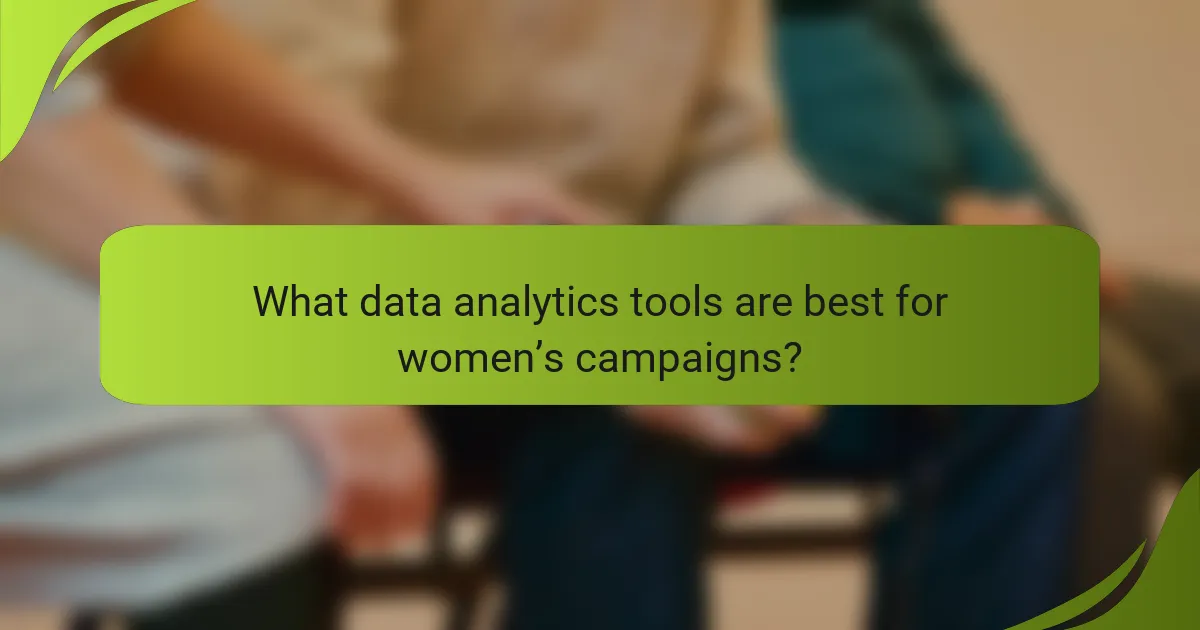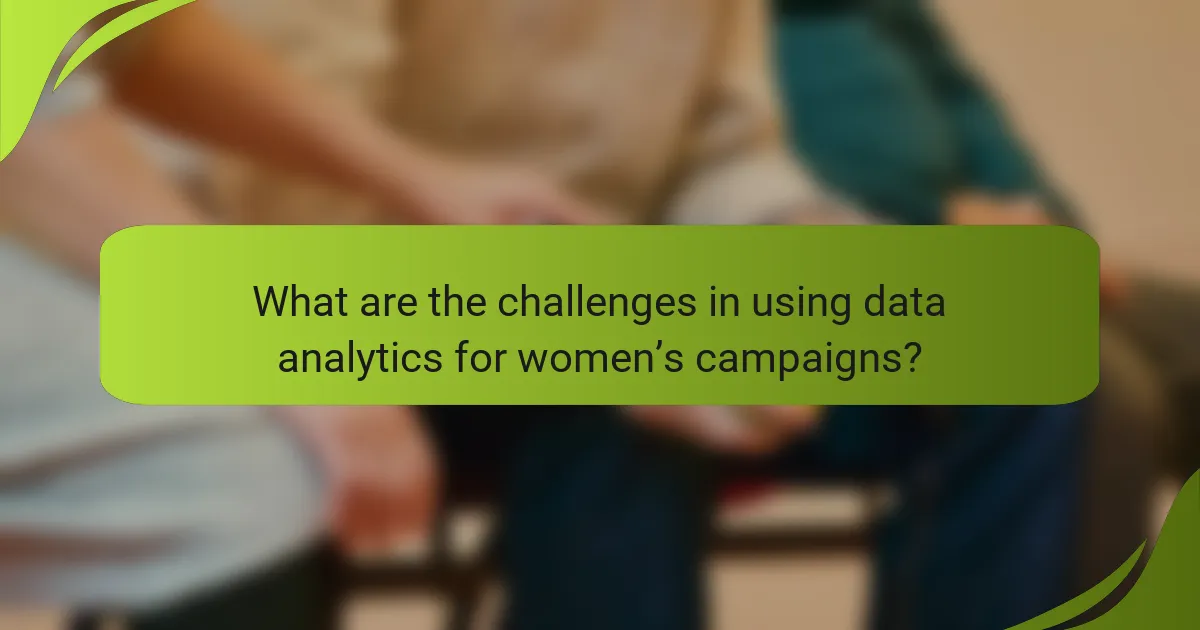Data analytics plays a crucial role in enhancing the effectiveness of women’s campaigns by offering valuable insights into audience preferences and behaviors. By utilizing tools like Google Analytics and Tableau, campaigns can be customized to better engage their target demographic, ultimately leading to improved outcomes and stronger connections. Tracking key metrics such as conversion and engagement rates further allows for the optimization of content strategies tailored specifically for women.

How can data analytics enhance women’s campaign effectiveness?
Data analytics can significantly improve the effectiveness of women’s campaigns by providing insights into audience preferences, behaviors, and engagement patterns. By leveraging these insights, campaigns can be tailored to resonate more deeply with their target demographic, leading to better outcomes.
Improved audience targeting
Data analytics allows campaigns to identify and segment their audience based on various criteria such as demographics, interests, and online behavior. This targeted approach ensures that messaging is relevant and reaches the right individuals, increasing the likelihood of engagement.
For instance, using analytics tools, a campaign can discover that women aged 25-35 in urban areas are more likely to respond to specific themes or products. This information enables the campaign to focus its efforts on that segment, optimizing resource allocation.
Personalized content recommendations
With data analytics, campaigns can create personalized content that speaks directly to the interests and needs of their audience. By analyzing past interactions, preferences, and feedback, campaigns can tailor messages that resonate more effectively.
For example, if analytics reveal that a segment of women prefers video content over articles, the campaign can prioritize video formats to enhance engagement. This personalization fosters a stronger connection with the audience, making them feel valued and understood.
Increased engagement metrics
Utilizing data analytics can lead to improved engagement metrics such as click-through rates, shares, and comments. By understanding what content performs best, campaigns can refine their strategies to boost interaction.
For instance, if analytics show that posts featuring user-generated content receive higher engagement, campaigns can encourage their audience to share their own stories or experiences. This not only increases engagement but also builds community around the campaign.
Optimized ad placements
Data analytics helps in determining the most effective platforms and times for ad placements, ensuring that campaigns reach their audience when they are most active. By analyzing user behavior across different channels, campaigns can allocate their budgets more efficiently.
For example, if analytics indicate that women engage more with ads on social media during weekends, campaigns can schedule their ad spend accordingly. This strategic placement maximizes visibility and enhances the chances of conversion.

What data analytics tools are best for women’s campaigns?
Effective data analytics tools for women’s campaigns include Google Analytics, Tableau, and HubSpot. These platforms provide insights into audience behavior, enhance data visualization, and automate marketing processes, respectively, making them essential for tailoring content to women.
Google Analytics for audience insights
Google Analytics is a powerful tool for understanding the demographics and behaviors of your audience. By tracking metrics such as age, gender, and interests, you can tailor your campaigns to resonate more with women. Utilize features like audience segmentation to create targeted content that speaks directly to their preferences.
To maximize its effectiveness, set up goals and conversion tracking to measure how well your content performs with female audiences. Regularly review your reports to identify trends and adjust your strategies accordingly.
Tableau for data visualization
Tableau excels in transforming complex data into clear, visual formats that are easy to interpret. This tool allows you to create interactive dashboards that can highlight key trends in women’s engagement with your campaigns. Visualizations can reveal insights that might be missed in raw data, helping you make informed decisions.
Consider using Tableau to compare different campaign performances or demographic segments. This can help you identify which content types resonate best with women, enabling you to refine your approach effectively.
HubSpot for marketing automation
HubSpot is an all-in-one marketing automation platform that streamlines your campaigns targeting women. It offers tools for email marketing, social media management, and lead nurturing, allowing you to engage with your audience at various touchpoints. Automation features can help you send personalized content based on user behavior and preferences.
To leverage HubSpot effectively, create buyer personas for your female audience segments and tailor your messaging accordingly. Regularly analyze the performance of your automated campaigns to ensure they meet the needs of women and adjust your strategies based on the insights gained.

What metrics should be tracked in women’s campaigns?
To effectively tailor content for women’s campaigns, key metrics such as conversion rates, click-through rates, and engagement rates should be tracked. These metrics provide insights into how well your content resonates with the target audience and help optimize future strategies.
Conversion rates
Conversion rates measure the percentage of users who take a desired action, such as making a purchase or signing up for a newsletter. In women’s campaigns, a high conversion rate indicates that the messaging and content are effectively appealing to the audience. Aim for conversion rates in the range of 2-5% for e-commerce campaigns targeting women.
To improve conversion rates, consider A/B testing different calls to action, visuals, and offers. Ensure that the landing pages are optimized for mobile devices, as many women shop online using smartphones.
Click-through rates
Click-through rates (CTR) indicate the percentage of users who click on a specific link compared to the total number of users who view the content. A good CTR for email campaigns targeting women typically ranges from 15-25%. This metric helps assess the effectiveness of subject lines and content relevance.
To enhance CTR, use compelling headlines and visuals that resonate with women’s interests. Personalization can significantly boost CTR, so segment your audience based on preferences and behaviors.
Engagement rates
Engagement rates reflect how actively users interact with your content, including likes, shares, comments, and time spent on the page. High engagement rates indicate that the content is resonating well with women. Aim for engagement rates of around 1-3% on social media platforms.
To foster higher engagement, create content that encourages interaction, such as polls, quizzes, or user-generated content campaigns. Regularly analyze which types of content generate the most engagement and adjust your strategy accordingly.

How to segment audiences for women’s campaigns?
Segmenting audiences for women’s campaigns involves categorizing potential customers based on shared characteristics to tailor content effectively. This approach enhances engagement and improves campaign outcomes by addressing the specific needs and preferences of different groups.
Demographic segmentation
Demographic segmentation focuses on quantifiable characteristics such as age, income, education, and marital status. For women’s campaigns, understanding these factors can help identify target groups, such as young professionals or mothers, and tailor messaging accordingly.
For instance, a campaign aimed at women aged 25-35 may highlight career advancement opportunities, while one targeting mothers might emphasize family-friendly products. Using tools like surveys or existing customer data can facilitate this segmentation.
Behavioral segmentation
Behavioral segmentation categorizes audiences based on their interactions with products or services, including purchasing habits, brand loyalty, and usage frequency. This method allows campaigns to target women who are more likely to engage with specific content or offers.
For example, a campaign could focus on women who frequently shop online versus those who prefer in-store experiences. Analyzing purchase history and online behavior can reveal insights that drive personalized marketing strategies.
Psychographic segmentation
Psychographic segmentation delves into the attitudes, interests, and values of women, providing a deeper understanding of their motivations. This approach can enhance campaigns by aligning messaging with the emotional and lifestyle factors that resonate with different segments.
For instance, a campaign promoting sustainable products may appeal to environmentally conscious women, while one focused on luxury items might target those who value status and exclusivity. Conducting focus groups or utilizing social media analytics can help uncover these psychographic insights.

What are the challenges in using data analytics for women’s campaigns?
Using data analytics for women’s campaigns presents several challenges, including data privacy concerns and complexities in data interpretation. Addressing these issues is crucial for effectively tailoring content that resonates with female audiences.
Data privacy concerns
Data privacy is a significant challenge when utilizing analytics for women’s campaigns. With increasing regulations like GDPR in Europe and CCPA in California, organizations must ensure they handle personal data responsibly. Failing to comply can lead to hefty fines and damage to brand reputation.
To navigate these concerns, companies should prioritize transparency with their audience about data usage. Implementing clear consent mechanisms and allowing users to opt-out of data collection can foster trust and enhance engagement.
Data interpretation complexities
Interpreting data accurately is essential yet challenging in women’s campaigns. Different demographics may respond uniquely to various content types, making it difficult to draw generalized conclusions. Misinterpretation can lead to misguided strategies that fail to connect with the target audience.
To mitigate this, marketers should segment their data analysis by age, interests, and purchasing behavior. Employing A/B testing can also help identify which content resonates best with different segments, allowing for more tailored and effective campaigns.


